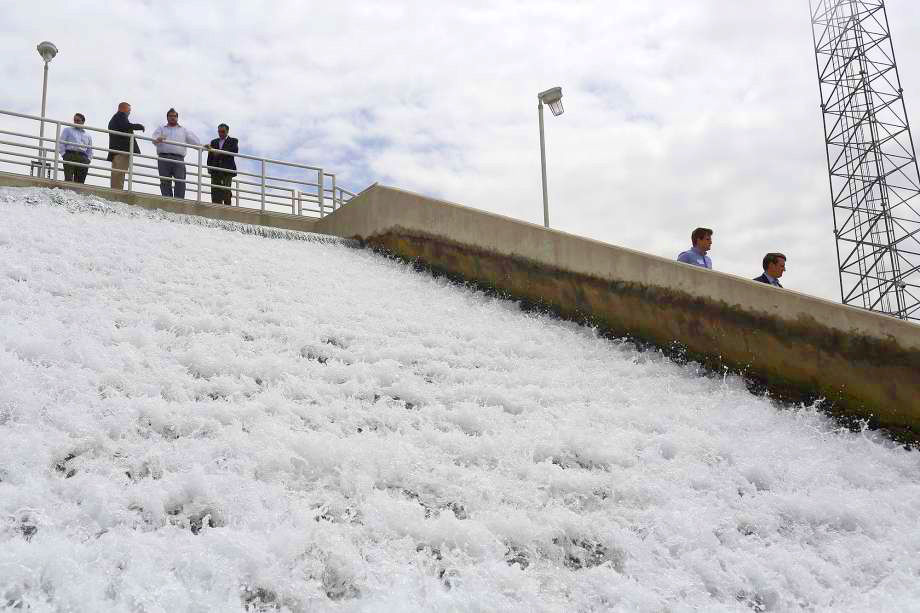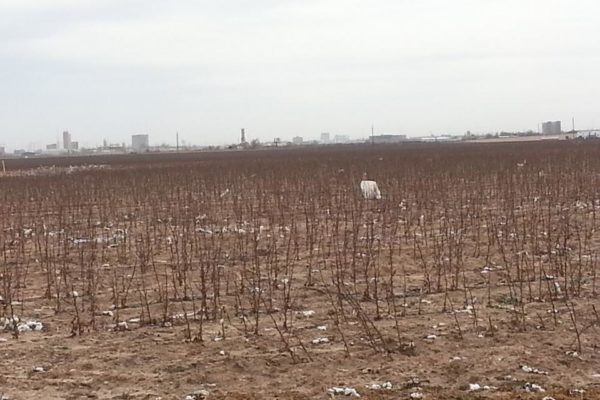The health of Texas aquifers depend on the state’s ability to keep rural Texas lands free of development. Here, state officials get a closer view of the aerators treating Carrizo Aquifer water in 2014. Photo: LISA KRANTZ /SAN ANTONIO EXPRESS-NEWS
by Blair Calvert Fitzsimons, CEO, Texas Agricultural Land Trust. bfitsimons@txaglandtrust.org
It’s the beginning of another legislative session, and while water may not be top of the agenda, we’re never off the hook. Someday, this state will face another serious drought. Through its regional planning process, Texas is far ahead of most other states when it comes to providing for future water needs. Overlooked in the process, however, is the role of private land conservation – and the need to protect the land where the rain falls. Through the No Land No Water campaign, launched last week by the Texas Ag Land Trust, we hope to raise awareness for the value of private working lands as irreplaceable contributors to the state’s water supply.
When it rains in Texas, that rain falls largely on privately-owned farms and ranches. In fact, 97% of Texas’ lands are in rural, private ownership. With proper stewardship, these lands capture and clean the water that recharges our aquifers and rivers, and suppies our drinking water. Unfortunately, Texas is losing her rural lands at an alarming rate to development and fragmentation, which can lead to increased erosion, sedimentation in rivers and reservoirs, polluted runoff, limited aquifer recharge, and added pressure on municipalities and water districts to invest in costly water treatment and collection infrastructure. The conservation of Texas’ private working lands is one of the most immediate and cost-effective strategies to ensure a future of abundant, clean water for ALL Texans.
As early as 1947, President Lyndon B. Johnson recognized the value of protecting open space, saying “Saving the water and the soil must start where the first raindrop falls.” If we are to ensure sufficient water supplies for our future, we need to act today to protect the lands where that first raindrop falls. Texas decision-makers are beginning to understand this concept. In his keynote address to the Texas Wildlife Association’s annual conference last July, Speaker Joe Straus commented that “…providing water is not all about pipes and pumps. It’s also about protecting our aquifers and rivers, and we need private stewardship to do so. Almost every drop of water in this state falls first on private property.”
Initial steps have been taken. In 2015, lawmakers appropriated $2 million to the Texas Farm and Ranch Lands Conservation program to provide one-time payments to landowners who agree to permanently keep their land in agricultural use, forego fragmentation and development rights, and thus protect valuable watersheds and aquifer recharge areas. An analysis of the program conducted by the Texas A&M Institute of Renewable Natural Resources revealed that the state’s $2m investment resulted in approximately $12m in water value protected on an annual basis. Through No Land No Water, we hope to encourage more participation in and funding for this critical program. More Land More Water!
By 2060, Texas’ population will grow to 40–50 million people. If we are to ensure sufficient water supplies for these future populations, we need to act today to protect the lands that will help supply the water that goes into those pipes and pumps provided for by the state’s water plan.
It’s no secret that private landowners have been supplying food, fiber, and economic prosperity to our state for centuries. But we must not forget that their success and tenure on the land is also responsible for much of the clean drinking water that sustains our growing population. Whether you live in downtown Dallas or the outskirts of Alpine, you likely feel a great deal of pride in the heritage and cultural values that make you a Texan. If you are a Texan for Water, you are a Texan for Land. No Land No Water. Visit us on the web at www.NoLandNoWater.org and on social media @NoLandNoWater to learn more and get involved!




